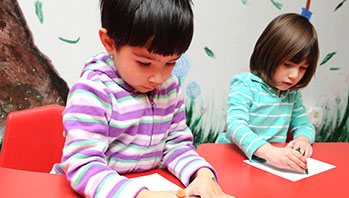- markers or crayons
- white paper
- groceries
MA Standards:
Writing/W.PK.MA.2: Use a combination of dictating and drawing to explain information about a topic.
Head Start Outcomes:
Literacy Knowledge/Early Writing: Uses scribbles, shapes, pictures, and letters to represent objects, stories, experiences, or ideas.
PreK Learning Guidelines:
English Language Arts/Composition 16: Use their own words or illustrations to describe their experiences, tell imaginative stories, or communicate information about a topic of interest.
Draw and Write Together: What’s for Dinner?

© Commonwealth of Massachusetts, Department of Early Education and Care (Jennifer Waddell photographer). All rights reserved.
ELA Focus Skills: Concepts of Print (Print Carries Meaning), Listening and Speaking, Vocabulary
Tell children to pretend that the girl from the story Bee-bim Bop! is coming to dinner at their house. Have children recall the foods in the bee-bim bop that the little girl likes so much. Ask, If the little girl came to dinner, would you have a recipe with a lot of plant foods? Have children explain their responses. Ask children to think of what they would like to serve the little girl for dinner. Ask questions such as,
- What foods would you like to eat?
- What plant foods are your favorites? Will you include them in your dinner?
Chart children’s responses. Review the responses and then have children draw a picture to describe what food they would like to serve the little girl for dinner. Then have them dictate or write a sentence describing their picture.
Adaptation: For centers with very young children, you may need to write a sentence frame on the page and let them fill in one or two words. For example, “We will have soup. I will buy .”
